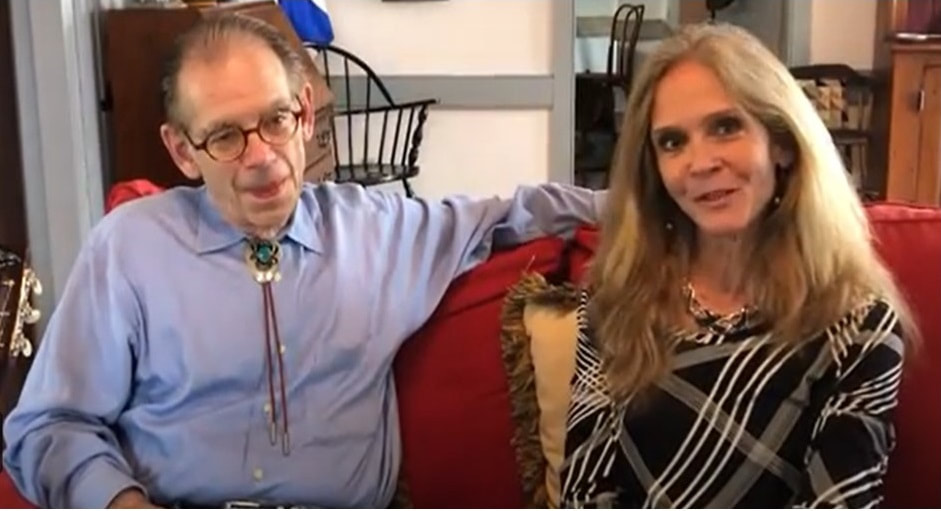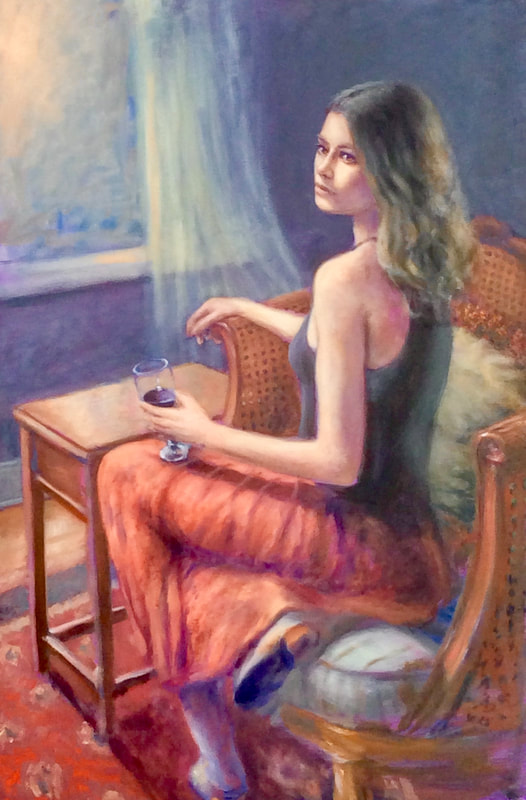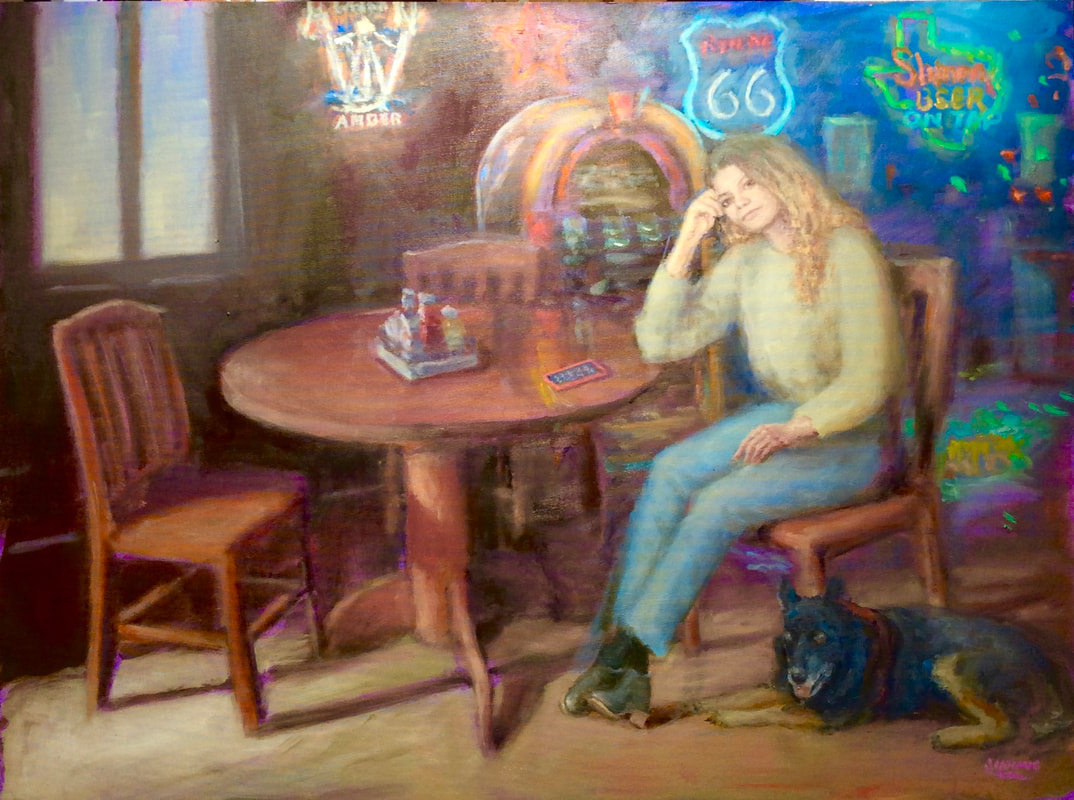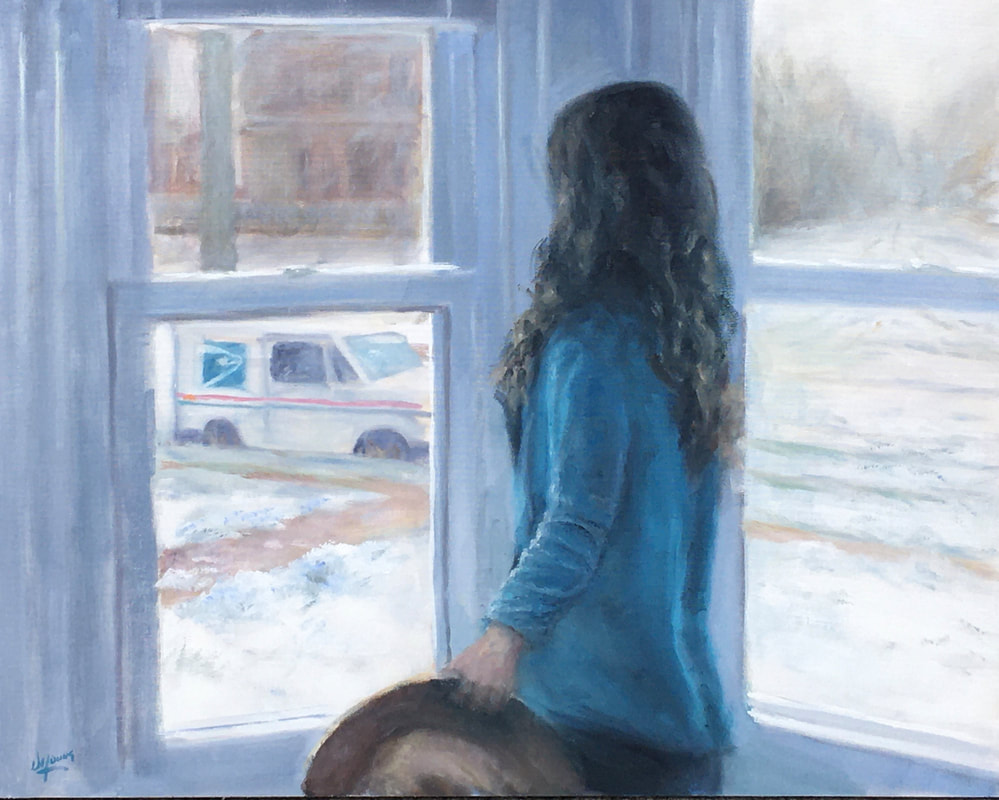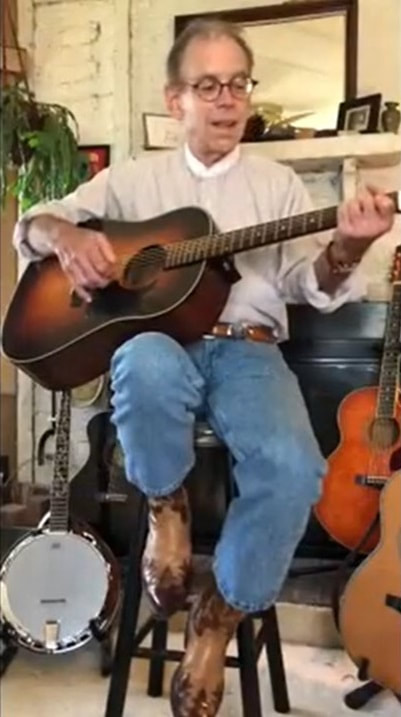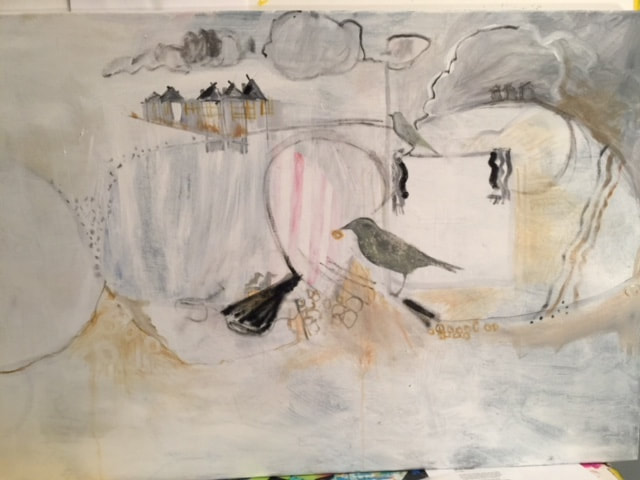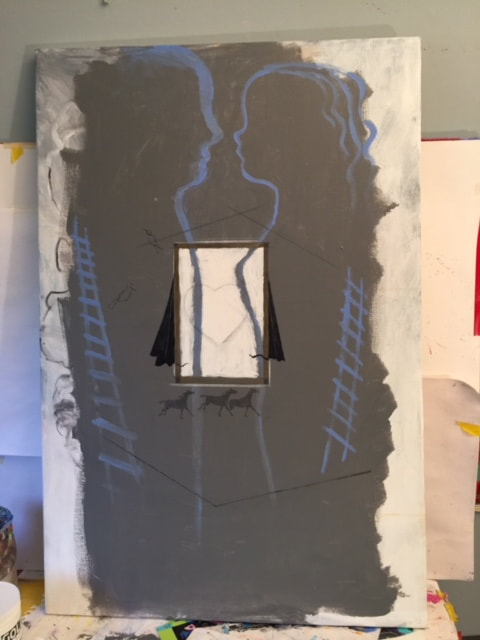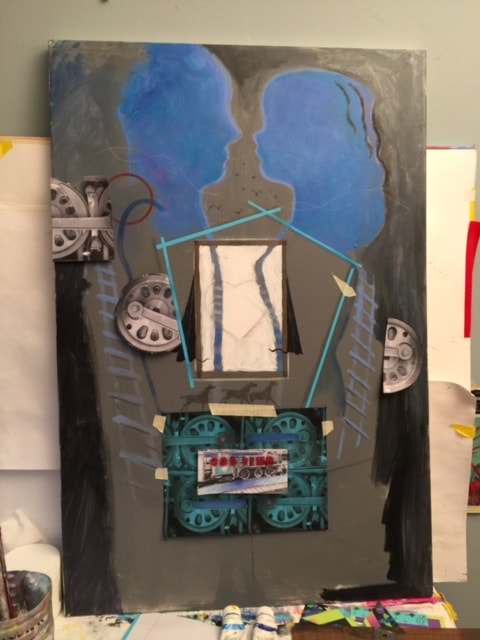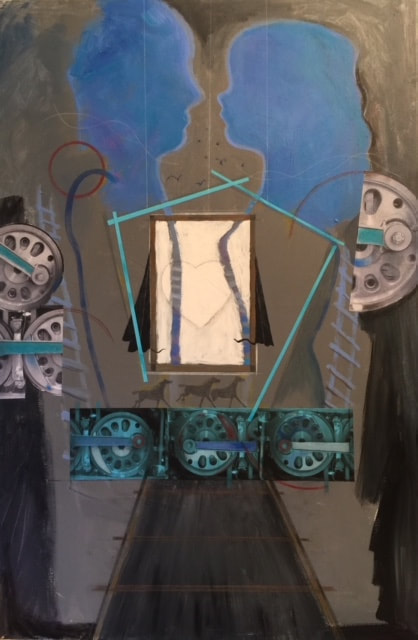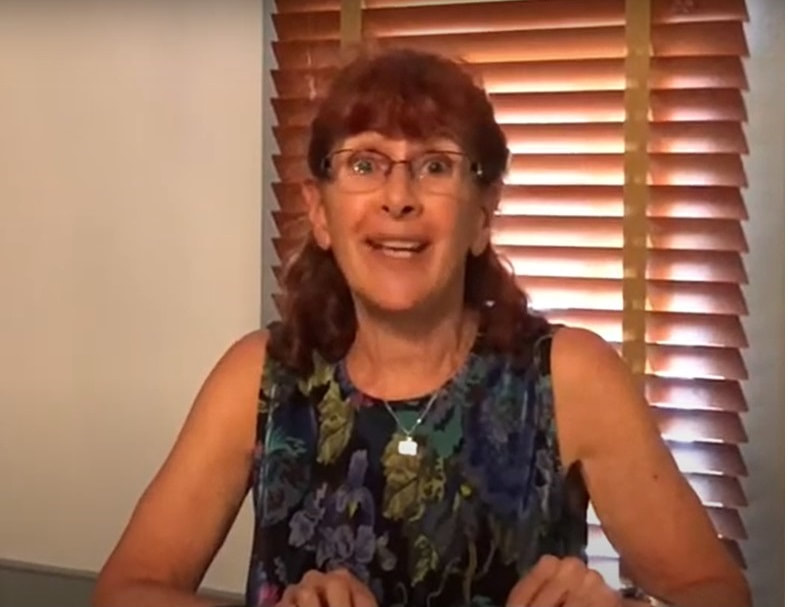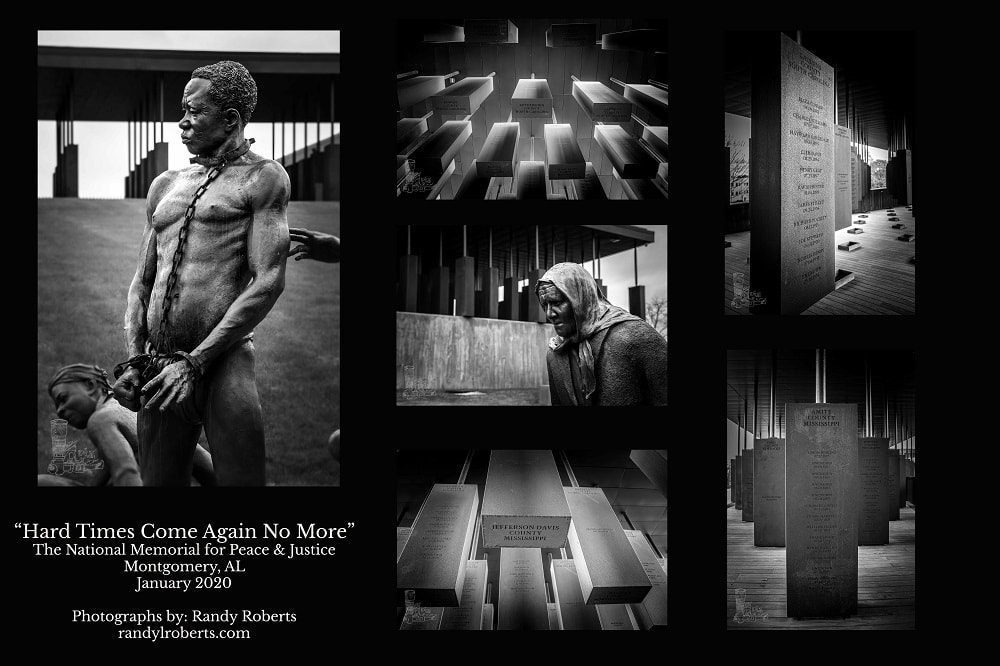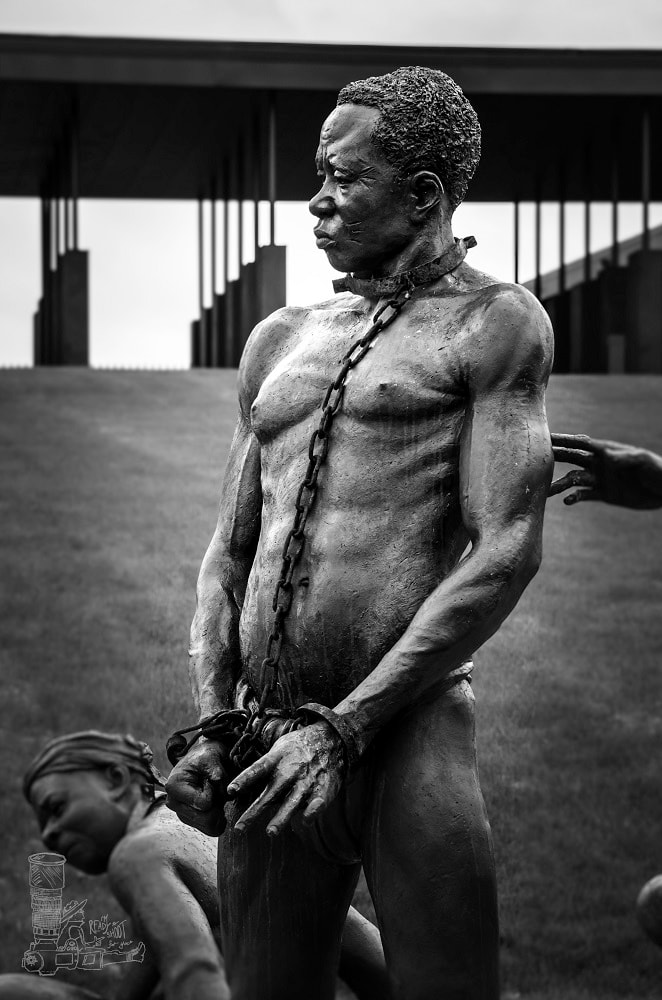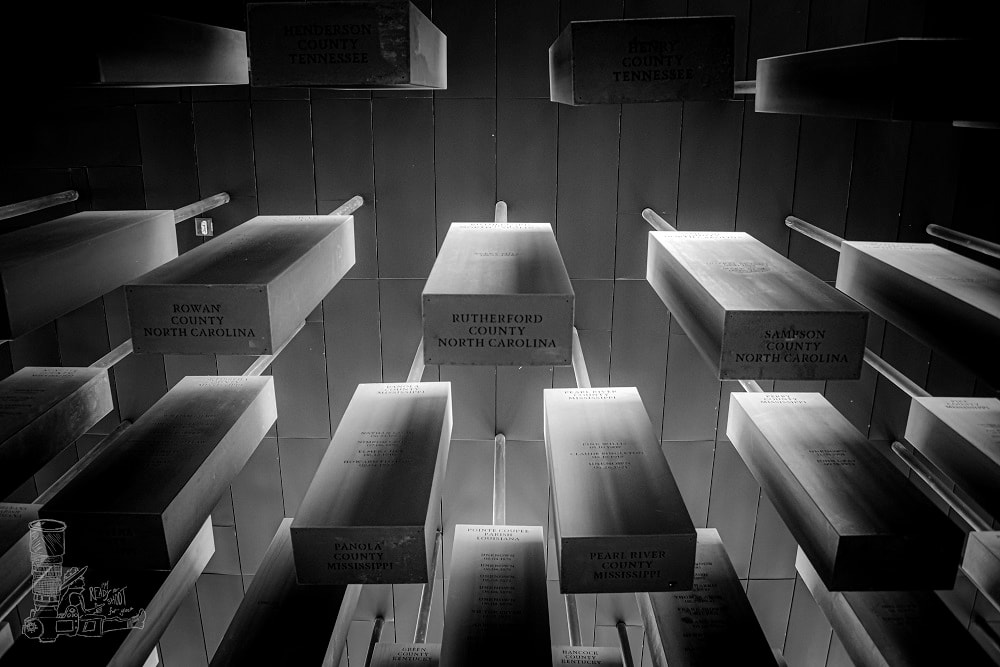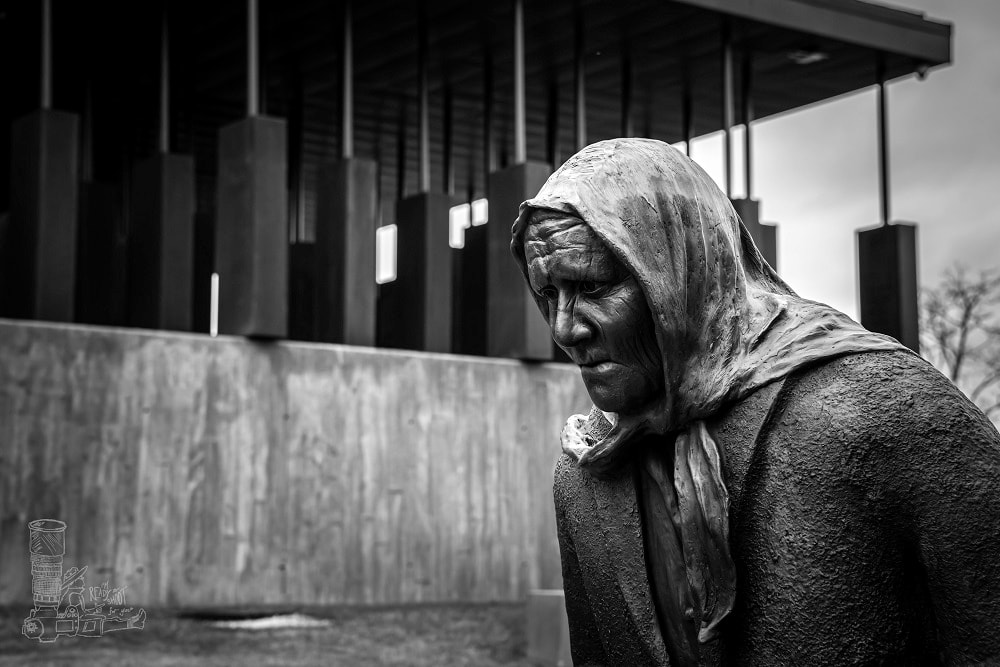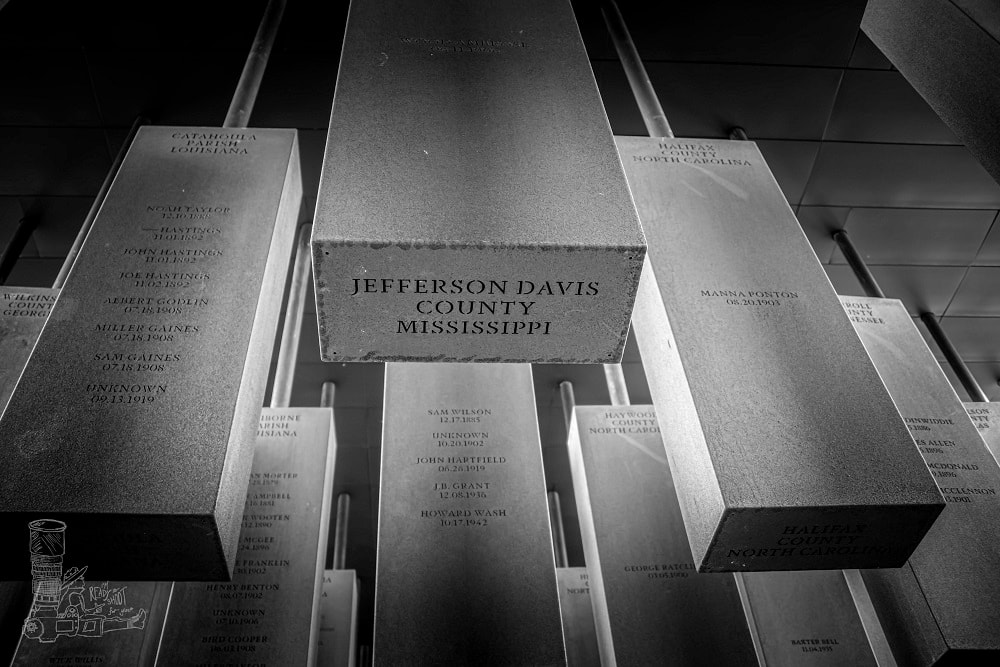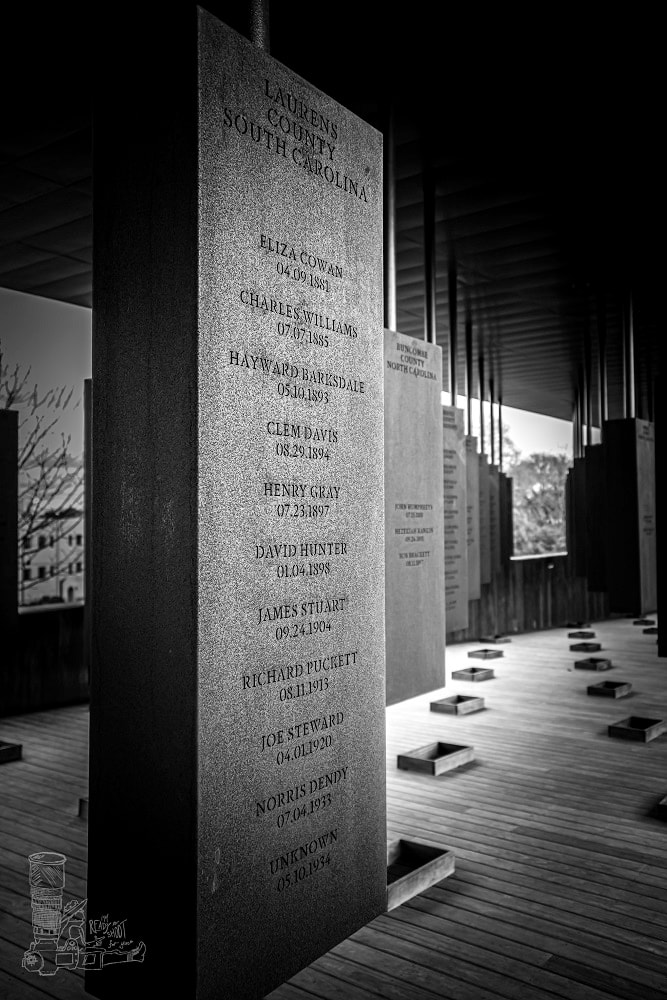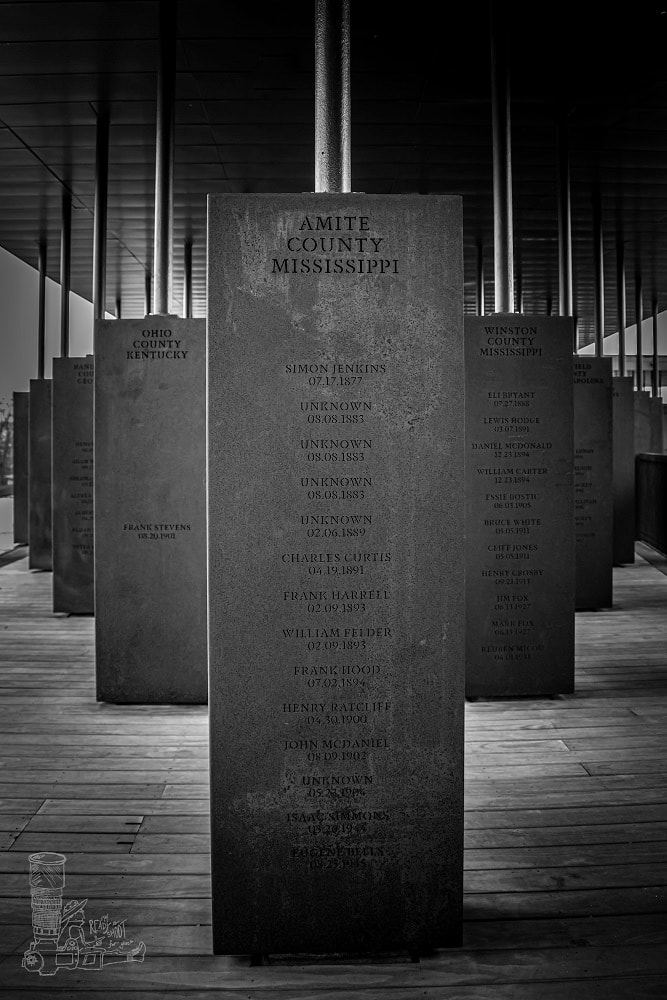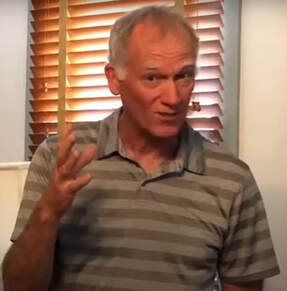
Art in the A.M.
Third Anniversary Performances
Art in the A.M. is a monthly performance featuring visual artists, RBWG writers, and songs by musician Stuart Vining. While we are not meeting face-to-face during the pandemic, we invite you to join us in celebrating the third anniversary of Art in the A.M.
|
Click here for an introduction to the project by Stuart Vining and Maribeth Fischer. Special thanks to Gillian Letonoff for filming these videos, as well as the videos we have been posting since April. |
Third Performance August 2020—Artist Dennis Young
Title: "A Door Opens"
© 2020 Dennis Young. Photos may not be used or altered in any way.
Dennis Young Interview
By Maribeth Fischer
Maribeth: You mentioned that after listening to the song, you choose two emotions that the music and lyrics evoked: anticipation and disappointment. You then asked Morgan (your model for this painting) to adopt poses suggesting these emotions. Do you often begin with an emotion? Aside from Morgan’s pose, how else does the emotion affect your choices?
Dennis: My fantasied story was that she had been through other days when she felt joyful anticipation of her lover only to be disappointed that he was not coming for her, as her father had predicted that he would only leave her crying. This painting highlights that tempered exuberance in the moment she turns her head towards the door she hears opening. The glass of wine she holds suggests that she is preparing herself for an unwanted revelation. But she loves him and with her boots on she is hopeful to follow him wherever he might go. And….. the next moment will tell.
I explained this all to Morgan and I shot multiple poses with her seated, laying on the couch looking up over her shoulder, and we even walked to a nearby restaurant to have her pose seated at a table looking towards the door (one of the other two paintings).I don’t typically start out with an emotion as I did here (with the song as the prompt). I will look for a possible story in the model’s face or pose and then project it onto the canvas. I will accentuate light on the face and promote full colors with a supporting cast of muted colors. These days I almost always am suggesting a story that the viewer can elaborate on. The eyes are usually the trailer to the movie.
Maribeth: I am fascinated by your statement that you started these paintings by identifying key emotions—I want to adopt this idea in a writing exercise somehow! That said, did your model also know what song you were using as inspiration? Had she heard of it or listened to it? Or was she working strictly with the idea of an emotion?
Dennis: When posing Morgan, I did explain what I was posing her for and gave her a synopsis of the song and how I viewed it. The song is older than she and I don’t think she had heard of it before.
Maribeth: Is there one specific emotion, or a few emotions, that you are especially drawn to as an artist?
Dennis: Hmm. You got me pondering that one, Maribeth. As I look over some of my paintings, I see the trend towards showing a woman who is at peace or even content with a certain something that she feels no need to reveal to others. So, it’s Mona Lisa’s contentment, with that smile that hints at confidence. (Look at me, insinuating myself into DaVinci’s studio!) These three paintings are a departure from my usual mode. The soundtrack song about anticipation/disappointment determined the pose and the setting of the stage.
Maribeth: Are there emotions you have never painted and don’t want to?
Dennis: Terror. I probably pass on terror. I must slip into my Bob Ross “happy clouds” and forego violent intrusions into the psyche. Except my Halloween paintings. That’s a different and appropriate story
Maribeth: You created three paintings for this song with completely different poses and backgrounds. How do you come up with the backgrounds—each of which is crucial to telling a story?
Dennis: For the main painting, there is hardly a background. Morgan sits with one leg pulled up. The window is to give the painting some depth and not leave her floating in space. The sheer curtain parts a bit with the rush of the door opening.
Morgan appears again seated at the bar table with the neon beer signs. This is how I posed her at the restaurant. The original scene comes from our repeat visit to the Pioneer Saloon 25 miles south of Las Vegas with the bare wood floors and rustic walls complete with a bullet hole. A relic of the Old West, it is where Clark Gable waited for word of his wife’s fatal airplane crash not far away. I wanted that western feel in this old bar that fits perfectly into the story of this young girl waiting for her rodeo loving boyfriend, though she may not fit into his lifestyle as she wants to: He loves his damned old rodeo as much as he loves me.”
The last painting is of my niece, Megan when she lived off-campus at UD a few years back. She is standing at the bay window so I added the scene outside. It’s a post-snowfall scene and nothing is happening. I added the parked postal truck and footprints in the snow implying that she is waiting for word from her lover, the outcome of which may be as bleak as the outside freeze.
Maribeth: In writing, we often have certain aspects that we especially love—a favorite line or description, etc. Is there a specific aspect of this painting that you especially like?
Dennis: Every time I pass this painting in my gallery I am immediately drawn to her head at the moment she is turning to see who is opening the door. Hope is restrained by flashbacks of past disappointments. The rest of the painting can be followed after this initial impression is struck.
Maribeth: What is it that you like best about the painting—over the other two that you choose?
Dennis: The saloon painting certainly tells the story but there are other distractions and colors. You could take her out of the painting and it would still hold together. Not so with the first one. In the “bleak” painting the face is not seen, just the anticipation. In “A Door Opens” you can see the mixed feelings all in her face.
Dennis: My fantasied story was that she had been through other days when she felt joyful anticipation of her lover only to be disappointed that he was not coming for her, as her father had predicted that he would only leave her crying. This painting highlights that tempered exuberance in the moment she turns her head towards the door she hears opening. The glass of wine she holds suggests that she is preparing herself for an unwanted revelation. But she loves him and with her boots on she is hopeful to follow him wherever he might go. And….. the next moment will tell.
I explained this all to Morgan and I shot multiple poses with her seated, laying on the couch looking up over her shoulder, and we even walked to a nearby restaurant to have her pose seated at a table looking towards the door (one of the other two paintings).I don’t typically start out with an emotion as I did here (with the song as the prompt). I will look for a possible story in the model’s face or pose and then project it onto the canvas. I will accentuate light on the face and promote full colors with a supporting cast of muted colors. These days I almost always am suggesting a story that the viewer can elaborate on. The eyes are usually the trailer to the movie.
Maribeth: I am fascinated by your statement that you started these paintings by identifying key emotions—I want to adopt this idea in a writing exercise somehow! That said, did your model also know what song you were using as inspiration? Had she heard of it or listened to it? Or was she working strictly with the idea of an emotion?
Dennis: When posing Morgan, I did explain what I was posing her for and gave her a synopsis of the song and how I viewed it. The song is older than she and I don’t think she had heard of it before.
Maribeth: Is there one specific emotion, or a few emotions, that you are especially drawn to as an artist?
Dennis: Hmm. You got me pondering that one, Maribeth. As I look over some of my paintings, I see the trend towards showing a woman who is at peace or even content with a certain something that she feels no need to reveal to others. So, it’s Mona Lisa’s contentment, with that smile that hints at confidence. (Look at me, insinuating myself into DaVinci’s studio!) These three paintings are a departure from my usual mode. The soundtrack song about anticipation/disappointment determined the pose and the setting of the stage.
Maribeth: Are there emotions you have never painted and don’t want to?
Dennis: Terror. I probably pass on terror. I must slip into my Bob Ross “happy clouds” and forego violent intrusions into the psyche. Except my Halloween paintings. That’s a different and appropriate story
Maribeth: You created three paintings for this song with completely different poses and backgrounds. How do you come up with the backgrounds—each of which is crucial to telling a story?
Dennis: For the main painting, there is hardly a background. Morgan sits with one leg pulled up. The window is to give the painting some depth and not leave her floating in space. The sheer curtain parts a bit with the rush of the door opening.
Morgan appears again seated at the bar table with the neon beer signs. This is how I posed her at the restaurant. The original scene comes from our repeat visit to the Pioneer Saloon 25 miles south of Las Vegas with the bare wood floors and rustic walls complete with a bullet hole. A relic of the Old West, it is where Clark Gable waited for word of his wife’s fatal airplane crash not far away. I wanted that western feel in this old bar that fits perfectly into the story of this young girl waiting for her rodeo loving boyfriend, though she may not fit into his lifestyle as she wants to: He loves his damned old rodeo as much as he loves me.”
The last painting is of my niece, Megan when she lived off-campus at UD a few years back. She is standing at the bay window so I added the scene outside. It’s a post-snowfall scene and nothing is happening. I added the parked postal truck and footprints in the snow implying that she is waiting for word from her lover, the outcome of which may be as bleak as the outside freeze.
Maribeth: In writing, we often have certain aspects that we especially love—a favorite line or description, etc. Is there a specific aspect of this painting that you especially like?
Dennis: Every time I pass this painting in my gallery I am immediately drawn to her head at the moment she is turning to see who is opening the door. Hope is restrained by flashbacks of past disappointments. The rest of the painting can be followed after this initial impression is struck.
Maribeth: What is it that you like best about the painting—over the other two that you choose?
Dennis: The saloon painting certainly tells the story but there are other distractions and colors. You could take her out of the painting and it would still hold together. Not so with the first one. In the “bleak” painting the face is not seen, just the anticipation. In “A Door Opens” you can see the mixed feelings all in her face.
Artwork Inspiration
|
Click here to listen to
Stuart Vining perform the song that was the inspiration for Dennis' paintings. |
RBWG Members Writings
Inspired By Dennis Young's Painting "A Door Opens"
When members signed up to write for this project, they had Dennis Young's painting for inspiration. They did not know the name of the painting, Dennis' theme, or the song that inspired the painting. This is what Art in the A.M. is about: writers, visual artists, and our musician, Stuart Vining, each presenting their interpretation of a prompt. Usually, the artwork is the prompt for the writing and music. This time we turned it around, and the music was the prompt for the artwork, that was then the prompt for the writing.
Click on the link below to read what our members were inspired to write.
Click on the link below to read what our members were inspired to write.
| art_in_the_am_part_iii_aug_2020_pdf.pdf | |
| File Size: | 278 kb |
| File Type: | |
Dennis Young
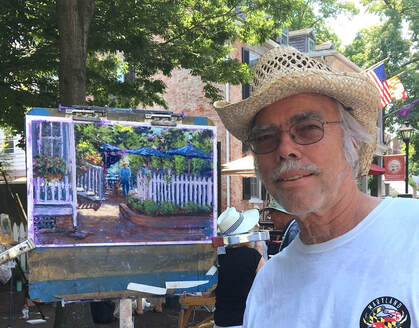
With no formal art training, Dennis Young is in his post medical practice phase where he paints prolifically in his recently opened Mo’zArt Gallery in Old New Castle, Delaware. He originally painted landscapes and portraits in his first years of med school but all of that was put on hold for 30 years while he was busy with family and his practice. A community watercolor class about 15 years ago interrupted that hiatus and and prompted these past years to be full and creative time at the easel with an intention to make up for lost time.
Dennis paints in the realistic style and lately with a little impressionistic accent. He has done many paintings en plein air, that is, out in the open in nature. These are typically cityscapes and paintings of iconic “postcard” scenes. He has painted in local and national competitions where his paintings have found new homes and garnered awards. By and large his favorite subject matter is the portrait and the human figure. Supposedly the hardest thing to paint, this is the most gratifying and popular painting subject. The eyes are the star of the show and the hands are the strong support. Portraits usually suggest a story with props or other figures around which a viewer may complete the creation with a studied interpretation.
Most of Dennis’ paintings are in oil but some are also done with soft pastels. Pastels easily lend themselves to creating works that are very colorful and immediate. Mixing colors is not an issue and his many hundreds of pastel pieces are very handy for completing “quick draw” paintings in competitions where a judged painting must be completed in 2 hours or less.
Mo’zArt gallery will continue to showcase Dennis’ plein air and studio paintings with larger portraits competing for wall space. He does a limited number of commissions per year. A new aspiration is to put together a short YouTube video of his painting process and to take on a few students to facilitate his learning how to show people how he starts a painting and “sculpts” the final product.
You can find Dennis' work at dennisyoungarts.com
Dennis paints in the realistic style and lately with a little impressionistic accent. He has done many paintings en plein air, that is, out in the open in nature. These are typically cityscapes and paintings of iconic “postcard” scenes. He has painted in local and national competitions where his paintings have found new homes and garnered awards. By and large his favorite subject matter is the portrait and the human figure. Supposedly the hardest thing to paint, this is the most gratifying and popular painting subject. The eyes are the star of the show and the hands are the strong support. Portraits usually suggest a story with props or other figures around which a viewer may complete the creation with a studied interpretation.
Most of Dennis’ paintings are in oil but some are also done with soft pastels. Pastels easily lend themselves to creating works that are very colorful and immediate. Mixing colors is not an issue and his many hundreds of pastel pieces are very handy for completing “quick draw” paintings in competitions where a judged painting must be completed in 2 hours or less.
Mo’zArt gallery will continue to showcase Dennis’ plein air and studio paintings with larger portraits competing for wall space. He does a limited number of commissions per year. A new aspiration is to put together a short YouTube video of his painting process and to take on a few students to facilitate his learning how to show people how he starts a painting and “sculpts” the final product.
You can find Dennis' work at dennisyoungarts.com
Second Performance July 2020—Mixed Media Artist Susan Frey
Title: Jack's Song
© 2020 Susan Frey. Photos may not be used or altered in any way.
|
Click here to see Susan talk about the song she chose and the challenges it presented as she created the mixed media work titled, "Jack's Song," with music by Stuart Vining. |
Susan Frey
Early in her artistic career, Susan Frey spent many hours in New York City's art museums. She attended the School of Visual Arts and later SUNY at Farmingdale, earning a degree in advertising art and design. In the Big Apple, she worked at three different advertising firms until she made family life a priority. Keeping up her love of art she free-lanced and attended art classes. Community art associations needed volunteers and board members, so Susan joined three and four at a time, winning many awards along the way.
In the summer of 2017, her solo show "Creatures" was displayed at Camp Rehoboth. In the summer of 2018, another solo exhibit "Balancing Acts" was displayed at the Rehoboth Art League. She also participated in an abstract show at the Peninsula Gallery in Lewes. Some pieces can be seen today at Camp Rehoboth, the Rehoboth Art League, the Mispillion Art Association in Milford, and five pieces in the Blue Moon restaurant in downtown Rehoboth Beach.
Susan continues to paint and work in mixed media. In her studio rock, jazz, and blues music sets the mood. Curious images evolve on the canvas. Objects are suspended between the real and imagined world. Brushstrokes, lines, marks, and colorful shapes eventually produce a finished piece.
You can find Susan on Facebook: Susan Frey Visual Artist.
In the summer of 2017, her solo show "Creatures" was displayed at Camp Rehoboth. In the summer of 2018, another solo exhibit "Balancing Acts" was displayed at the Rehoboth Art League. She also participated in an abstract show at the Peninsula Gallery in Lewes. Some pieces can be seen today at Camp Rehoboth, the Rehoboth Art League, the Mispillion Art Association in Milford, and five pieces in the Blue Moon restaurant in downtown Rehoboth Beach.
Susan continues to paint and work in mixed media. In her studio rock, jazz, and blues music sets the mood. Curious images evolve on the canvas. Objects are suspended between the real and imagined world. Brushstrokes, lines, marks, and colorful shapes eventually produce a finished piece.
You can find Susan on Facebook: Susan Frey Visual Artist.
First Performance June 2020—Photographer Randy Roberts
Title: "Hard Times Come Again No More"
© 2020 Randy Roberts. Photos may not be used or altered in any way.
|
Randy began working on the Art in the A.M. Third Anniversary project in January, 2020 choosing the theme of "Hard Times Come Again No More"--which by spring became a timely topic. Click here to listen to Randy Roberts speak about the photographs he contributed for the project, with music by Stuart Vining. Below, are Randy's photos. |
Randy Roberts
Randy Roberts is an avid photo hobbyist who has an absolute love of the outdoors. Whether shooting nature and wild animals with brilliant colors or shooting people on the street in black and white, Randy feels at home behind the lens of his camera. He also loves making each photo special by manufacturing custom frames. Randy’s work has been in Delaware Beach Life several times and he was honored with the cover photograph for the August 2017 issue. He also received first place in the annual Delaware Beach Life Photography Contest--People Category for 2018. This work was highlighted in their October 2018 issue. Randy’s favorite demonstration of his work has taken place during the Art in the A.M. feature of the Rehoboth Beach Writers Guild, where he says it is a treat for him to hear what stories his work inspires.
To find Randy’s work and details, go to www.randylroberts.com
To find Randy’s work and details, go to www.randylroberts.com
Link to The National Peace and Justice Memorial/The Legacy Museum
Click here
Copyright © Rehoboth Beach Writers Guild

